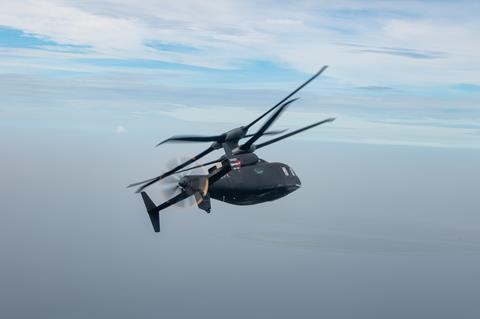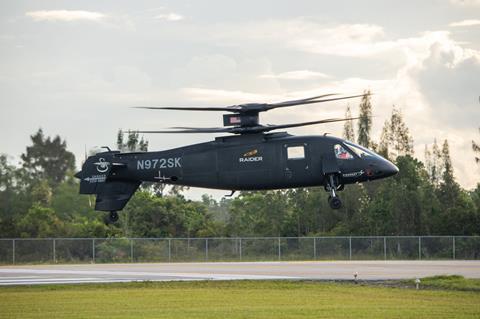Helicopter manufacturer Sikorsky will not pursue further challenges to the US Army’s decision to award rival Bell a multi-billion dollar contract for the service’s next-generation rotorcraft.

Connecticut-based Sikorsky said on 18 April it will not pursue additional legal action related to its loss in the Future Long Range Assault Aircraft (FLRAA) programme.
“We are disappointed with the… decision and remain convinced that our Defiant X offering represented both the best value for the taxpayer and the transformational technology that our war fighters need to execute their complex missions,” the Lockheed Martin subsidiary says.
The FLRAA design will ultimately replace the Sikorsky UH-60 Black Hawk as the army’s utility-lift and troop carrying helicopter. The service currently operates a fleet of some 2,300 UH-60s.
Last December, the army selected Bell’s V-280 tiltrotor over the Defiant X compound coaxial design as the winner of the FLRAA competition. Lockheed filed a formal protest of that decision, triggering a more than three-month review of the army’s decision making process by auditors at the US Government Accountability Office (GAO).
On 6 April, the GAO publicly declared the army had acted appropriately within the context of US government procurement rules, upholding the V-280 selection.
The agency subsequently released the detailed findings of its report on 13 April. The GAO confirmed the initial army assessment that Sikorsky’s bid was “unacceptable”, due to insufficiently detailed design architecture.
The report also notes the Defiant X cost estimate prepared by Sikorsky was roughly half of the price submitted by Bell. However, army selection authorities and the GAO evaluated that price as unreliable, owing in part to the lack of design specificity.
The GAO also notes the army weighted flight performance more than price in its evaluation criteria, a practise the agency deemed acceptable. While specifics were not provided, the service gave the V-280 a higher performance ranking than the Defiant X.

Sikorsky says it will now focus on existing contracts with the army to deliver new UH-60 Black Hawks and sustain the existing fleet.
“We value our long-standing partnership with the US Army, and serving their missions remains our top priority,” Sikorsky says.
The company is also a finalist for a separate army helicopter competition to design a high-speed, armed rotorcraft – known as the Future Attack Reconnaissance Aircraft (FARA) – to replace the army’s retired Bell OH-58 Kiowa scout type.
Sikorsky and Bell are also the two finalists in the FARA programme. Sikorsky is competing another compound coaxial design it calls Raider X.
“We are focused on driving innovation and delivering the transformational Raider X for [FARA], modernised Black Hawks and future technology critical to mission readiness for the United States and allied nations,” Sikorsky says.
For its FARA bid, Bell has put forward a more conventional single-main and tail rotor concept known as the 360 Invictus.
Build on both FARA designs is nearly complete, but neither manufacturer has yet begun flight trials. GE Aerospace has repeatedly delayed delivery of its T901-GE-900 Improved Turbine Engine (ITE) that will power not only both FARA prototypes, but eventually the army’s UH-60s and Boeing AH-64 Apache attack helicopters.
The army and GE now expect to deliver the ITE some time in the autumn of 2023, with FARA flight testing likely occurring in 2024.





























